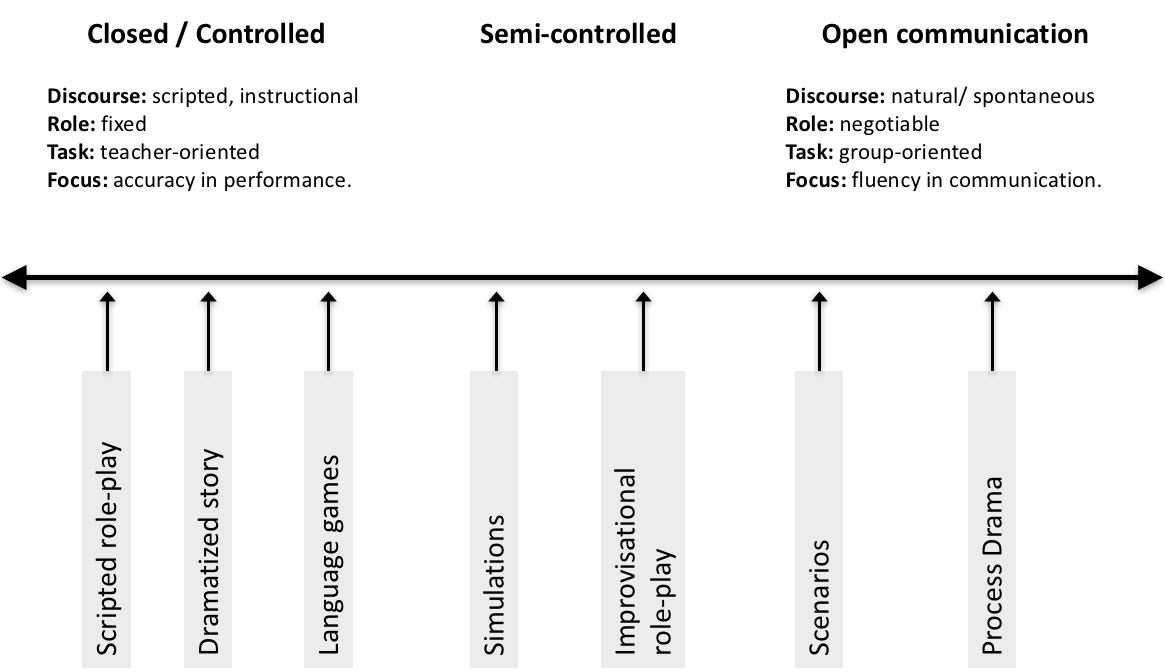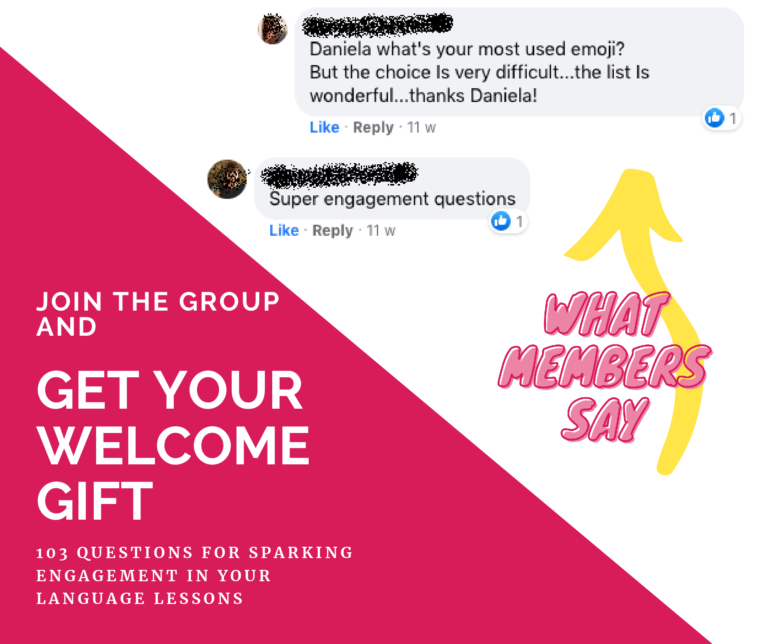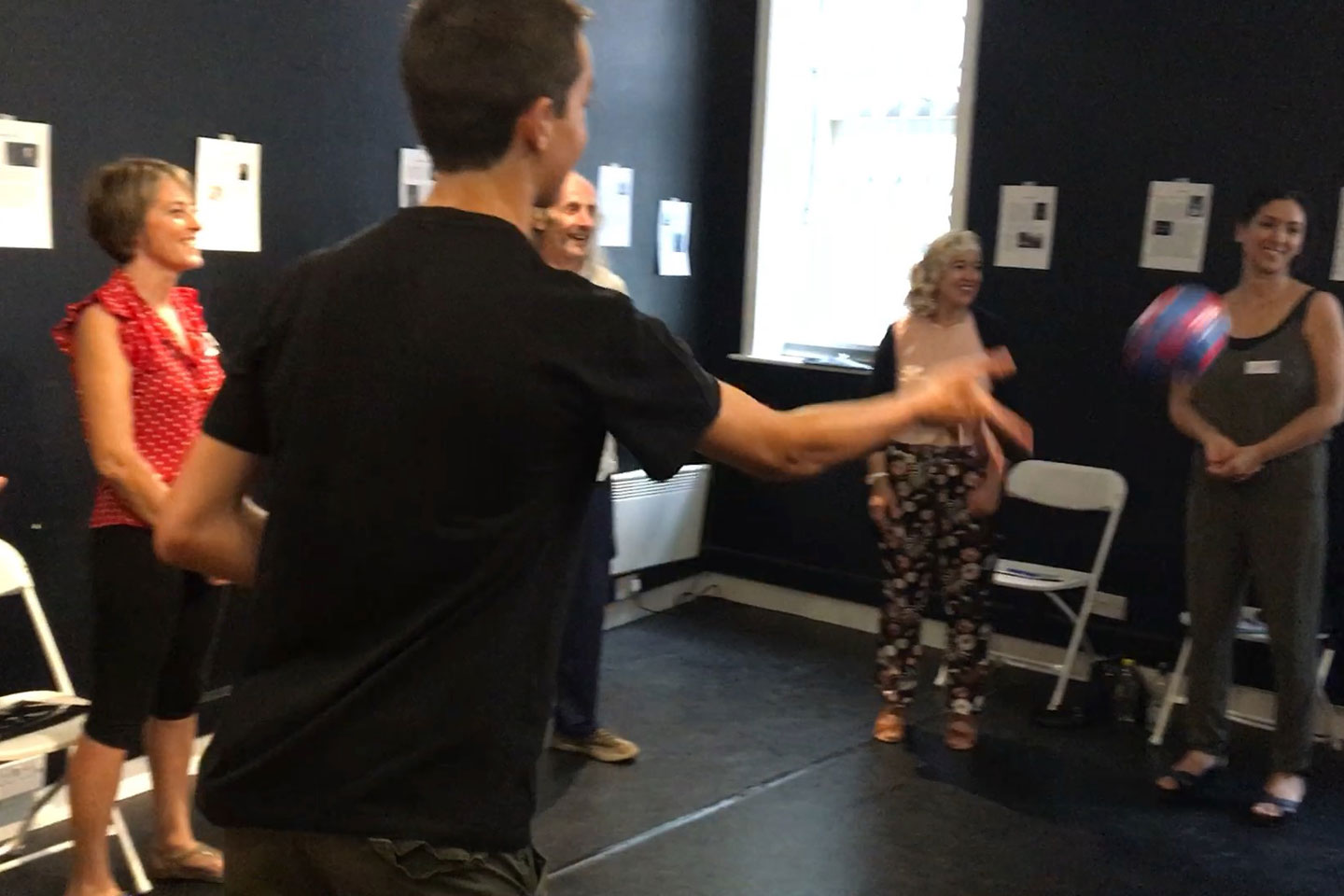
Do you know when you feel like introducing some consistent drama work in your language lessons but you haven’t got a clue of where to get started and what exercises to propose? Some teachers think that reading a play script in class and then playing it out is the way of using drama for teaching languages. Which is true, except for the fact that it is not the only way to introduce drama in class. In fact, there are actually 7 types of drama exercises you can use in accordance with the level of competence of your students, the training goals of your lessons and the skills you aim at developing. Having a variety of choices we can choose from is so good! After all, the more cards you can choose from, the more likely you will be effective. I love choices!
Well, my friend, make yourself comfortable, grab a cup of coffee and get ready for reading this article because I’m going to tell you what the 7 types of drama-based approaches are, when to use each approach and why.
Teaching languages through drama and playing drama scripts
In a recent article (see ‘Does learning languages through drama mean playing drama scripts’) I wrote about the difference between playing drama scripts and teaching through drama. In brief, teaching through drama is about designing lessons that facilitate the students’ learning process. Good teachers put that facilitation in place when they set the training goals for a lesson or a course, they select the contents they want to explore and finally they decide on the methodologies they will use. Now, with regard to the drama-based methodologies, we shall keep in mind we can choose among a variety of approaches. In the same article I mentioned Shin-Mei Kao’s and Cecily O’Neill’s classification of drama approaches for L2 teaching and learning. I also wrote I would have got back to this topic with a specific article. Well… here it is!
What are the drama approaches for L2 teaching and learning?
The authors Shin-Mei Kao and Cecily O’Neill classified the approaches we can use in drama-based language courses in their ‘Words into worlds: learning a second language through process drama’. The authors’ classification is a continuum of different drama approaches for L2 teaching and learning. Here it is:

The continuum shows 7 approaches. On the left hand side of the continuum we find the so called closed/ controlled approaches. Such approaches aim at consolidating the communicative structures and usually they propose basic instructions the students will have to stick to. The focus is on the accuracy of the performance since the main goal here is to absorb grammar structures or new vocabulary. The teacher will give very precise instructions and fixed roles to the students, whilst the students will execute the instructions as precisely as possible in order to practise them and memorise them. Scripted role-plays, dramatised stories and language games belong to this part of the continuum.
The more we move towards the right hand side of the continuum, the more the approaches we find focus on the ‘open communication’. Here we will ask the students to get natural and spontaneous in the discourses they will produce. In this part of the continuum the main goal is to communicate fluently. The teacher will give the students general guidelines within which the students will create and produce their performances. Scenarios (by Robert Di Pietro) and Process Drama belong to this part of the continuum.
Simulations and improvisational role-plays stick in the middle. In fact, they can serve either the controlled communication or the open communication depending on the instructions we will give. The instructions might give a precise framework or they can leave room for creativity.
Let’s take a closer look at the 7 approaches
Scripted role-plays are informal performances where students play predetermined roles. The teacher gives the students a script they will practise in pairs and then in front of the group. The goal is to absorb and fine tune grammar structures and vocabulary, questions and answers that are typical to a specific situation. For example: a dialogue titled ‘At the post office’. That is the classical example of dialogue we could find in any textbooks. Such dialogues are rather far from being realistic and authentic.
Dramatised stories are performances where students tell a story (a series of events) by following a script. In this case the script is a monologue. The goal is to improve the ability to describe events and situations, for instance: ‘My latest holidays’. For the same reason, dramatised stories don’t have dialogues.
Language games are playful exercises (such as quizzes, for instance) that help to consolidate specific structures and vocabulary. This is a kind of drill, as students will repeat the same structures in order to absorb them, but enjoyable and possibly fun.
Simulations are similar to role-plays, but without scripted dialogues. In fact, the teacher will give a detailed situation without dialogues and the students will produce informal performances. They can also produce their own scripted dialogues and they rehearse them. Simulations are closer to reality than role-plays, even though they are still far from being totally realistic as they can’t include all the inconveniences that happen in the real life.
Improvisational role-plays give the students a situation to unfold or a problem to solve. For example: ‘Sam is late for a job interview, the interviewer has been waiting for a candidate in his office.’ Students will have to unfold the performance on the spot without having the time for planning strategies or creating dialogues. The dialogues or monologues that will come out are totally spontaneous. There are thousands of different exercises in improvisation. I’m going to go back to this topic in another article as it is worth it to spend a few more words about it and to give you some examples of exercises you can do.
Scenarios belong to the method called Strategic Interaction. Scenarios are kinds of simulations where the whole group has to figure out how a communicative situation will unfold and they decide on the communicative strategies to put in place. Scenarios requires a specific work. I’m going to tell you more about this method another time.
Process Drama is a framework. Students will explore a specific topic through the mean of drama, research and many other methods depending on the inputs the teacher wants to provide the students with. The final outcome could not be necessarily a performance. Process Drama requires a lot of planning and a time span of at least a few lessons.

Shall we propose open communication approaches with beginner level students?
No doubt that, on one hand, closed/ controlled approaches fit the students who need to practise specific communicative functions, grammar structures or to absorb new words. On the other hand, intermediate and advanced students need to become more and more creative and spontaneous with the language they are learning. Nevertheless, according to my experience, in all groups there is always enough room for messing things up. By that I mean that even if you are teaching a group of beginners, it is effective and recommended to give them the chance to express themselves through exercises belonging to the open approaches. Of course, as a teacher who knows her students’ strengths and improvement areas, you will pay attention to three important things. Firstly, the open approach exercises for beginners will have a simple framework and simple instructions. Secondly, you won’t expect from your beginner students to produce complex discourses. On the contrary, you will expect them to produce basic sentences because that is what they are actually able to create spontaneously. Thirdly, you will introduce such exercises as soon as you realise the students got the hang of what they were expected to absorb and now they are ready for an extra challenge. Be aware, though: remember that even at that stage where you are launching an extra challenge, they are still within the learning process. This means the open approach exercises will help them to consolidate the structures and the contents they are working on with you. Here is an example. Some years ago I used to run conversation classes for beginners and I used to introduce drama exercises whenever I had the chance to do it. When we were drilling questions and answers for introducing ourselves (language game), for instance, I always gently pushed them to expand their introductions and add a few more pieces of information about themselves. Some students could say a few more words, some others gave it a try but returned to the structures practised in the game, some other students were able to activate short sentences and words they simply felt like adding to the conversation. It didn’t really matter to me how many words or sentences they could speak beyond the drill. The most important thing is that they felt motivated to say something more, to make an extra effort in order to communicate and share. It worked always very well. The shyest ones were feeling safe because nobody was expecting them to show off competences they didn’t own. The bravest ones had some extra room for testing their skills.
Shall we propose closed/controlled approaches with advanced level students?
As a consequence, closed/ controlled approach exercises can fit your intermediate or advanced level students whenever they need to analyse contents, split those contents into smaller chunks and eat them up. Everybody needs to practise and revise.
For instance, in ‘Learn English through Drama’ courses we use all the 7 approaches within a methodological framework designed for intermediate level students who need to enrich their vocabulary and to become more fluent in speaking English. In these courses we use a lot of closed approach exercises as well as open approach exercises. As we move forwards, we involve the students in drama-based exercises that require a creative effort. We don’t ask them to get creative on the very first days of course. On the contrary, we gently walk the students through the continuum.
Choices mean freedom
Teaching through drama means knowing all the 7 approaches, knowing for whom they are more suitable, when to propose them and why. I don’t know what you think about this, but I believe having the chance to choose among 7 types of exercises for teaching through drama gives me the freedom to select what serves better my students.
What’s next? Where should you get started?
If you are thinking of introducing drama in your lessons or you have been already teaching through drama but you want to try something new, my suggestion is: choose something basic to implement. Stay tuned with this blog ‘cause I’m going to get back soon with examples of exercises from the closed approaches and to walk you through how you can propose it in class.
Want more support?
Join the Facebook group Independent Language Teachers Collective to get daily advice, tons of free training and to branch out with other independent language teachers like you!
ALSO…
Available only for the Collective members: free list 103 question for sparking engagement in your language lessons.
This is what members say about the freebie:

Join in the Collective and grab your welcome gift:
Join Facebook Group
